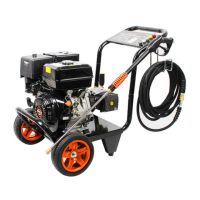What to do if the drain plug is loose on my VEVOR G250A?
- MMatthew FordSep 1, 2025
Tighten the drain plug on your VEVOR Pressure Washer.

What to do if the drain plug is loose on my VEVOR G250A?
Tighten the drain plug on your VEVOR Pressure Washer.
What to do if the chemical screen is not in the chemical for my VEVOR Pressure Washer?
Ensure the end of the chemical hose is fully submerged in the chemical when using your VEVOR Pressure Washer.
What to do if there is a loose hose connection on my VEVOR Pressure Washer?
Tighten the loose hose connection on your VEVOR Pressure Washer.
What to do if the chemical filter is clogged in my VEVOR G250A Pressure Washer?
Clean the chemical filter of your VEVOR Pressure Washer.
What to do if my VEVOR G250A Pressure Washer has low oil?
Add the required amount of oil to your VEVOR Pressure Washer.
What to do if the water filter screen is clogged in my VEVOR G250A Pressure Washer?
Remove and clean the water filter screen of your VEVOR Pressure Washer.
What to do if there is air in the hose of my VEVOR G250A Pressure Washer?
Turn off the engine and the water source. Disconnect the water source from the pump inlet, then turn the water source on to remove air from the hose. When a steady stream of water is present, turn the water source off. Reconnect the water source to the pump inlet and turn on the water source. Squeeze the trigger to remove any remaining air.
| Brand | VEVOR |
|---|---|
| Model | G250A |
| Category | Pressure Washer |
| Language | English |
Indicates an imminent hazardous situation which, if not avoided, will result in death or serious injury.
Indicates a potentially hazardous situation which, if not avoided, could result in death or serious injury.
Indicates a potentially hazardous situation which, if not avoided, may result in minor or moderate injury.
Used without the safety alert symbol indicating potentially hazardous situation which, if not avoided, may result in property damage.
Details risks of ignition from gasoline vapors, fuel expansion, explosive environments, and overheating.
Covers risks from exhaust fumes and chemical cleaning fluids, with prevention methods.
Warns about contact with hot engine components and the risk of serious burns.
Addresses risks from using acids, toxic chemicals, or flammable solvents, and recommends protective measures.
Highlights dangers of improper operation, kickback, and misuse by children.
Warns about high-pressure fluid penetration, amputation risks, and proper handling of leaks.
Details risks from high-velocity spray, projectiles, and accidental operation.
Warns about fatal electrical shock from spraying electrical outlets or connected objects.
Explains how to adjust the pressure setting of the washer for optimal cleaning.
Guides on selecting and using the correct spray nozzle for different cleaning tasks.
Provides guidance on consulting the engine owner's manual for maintenance recommendations.
Details the procedure for checking the oil level in the pump.
Step-by-step instructions for draining and refilling the pump oil.
Addresses excessive pressure issues caused by clogged nozzles and how to clean them.
Instructions for periodically checking and cleaning the water inlet filter screen.
Provides guidance for storing the engine and pump components to prevent damage.
